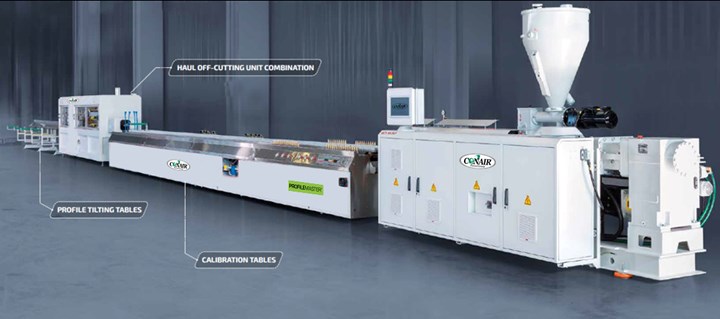Downstream Line for High-Precision Profiles
NPE2024: System features calibration and cooling tables, haul-offs, cutting units and tilting tables.
Share
Conair’s ProfileMaster is a complete line of downstream profile extrusion processing equipment for small to large profiles.
The line represents another new investment for Conair, which has not marketed a complete downstream profile extrusion product line like this one until now.
The ProfileMaster product line includes three major elements:
Calibration Tables: ProfileMaster calibration tables are available in four lengths and in single- or dual-line configurations to accommodate a full range of profile sizes and cooling requirements. All tables offer sturdy steel construction, with stainless steel used on the mounting plate, all wetted surfaces and on both ends. The top mounting plate includes c-rails that easily accommodate any combination of profile calibration tooling or cooling required — from ambient or compressed air, to water-jacketed profile tooling, to spray cooling or full-immersion vacuum cooling. Convenient ½-in. vacuum connections are served by either two or three 7.5-hp (5.5 kW) vacuum pumps, depending on table size. Recirculating water systems also include a cyclone unit to manage vacuum-water discharge while minimizing noise.
Alignment of calibration tables is simplified because of motorized position adjustments (up/down, forward/backward) and lateral adjustment valves. These calibration tables are available in lengths from 15 through 38 ft., depending on your process needs. They feature multiple powerful 7.5-hp vacuum pumps. Two pumps are used on tanks under 20 ft. Three pumps are used on tanks longer than that mark.

Haul-Off and Cutting Units: The ProfileMaster line includes a very wide range of haul-off (puller) and cutting unit options, including single- or dual-line configurations and combination haul-off/cutter units. Many processors prefer combination units, especially for small or medium-sized profiles, because the combination unit eliminates the need to position and align a separate cutting unit. Generally, separate haul-off and cutter units are used when handling the largest profile extrusions.
All haul-offs include logic to automatically synchronize speed with the extruder screw speed control and can integrate with gravimetric material dosing for stable production and consistent profile unit weight. Inside the fully enclosed safety cabinet of each haul-off, brushless AC vector motors provide steady pulling force using either a belt (for small product) or quick-change cleated pads (flat or v-type) to move the profile without creating marks or traces on the extrudate surface. Pressure on the profile product is regulated using pneumatically-driven pistons that move the upper pulling segment up or down to increase or decrease grip on the product.
Cutting units or combination units may be equipped for chipless guillotine (guillotine, heated guillotine, or blade) or motorized saw cutting, with options for up/down or horizontal blade movement.
Profile Tilting Tables. Pneumatically operated profile-tilting tables synchronize with extruder and haul-off line speed to receive and automatically tip (dump) finished profile extrusion segments into stacks for easy removal, packaging, shipment or storage. A range of tilting table sizes accommodates profiles up to 20 ft. (6 meters) in length.
Related Content
-
How Polymer Melts in Single-Screw Extruders
Understanding how polymer melts in a single-screw extruder could help you optimize your screw design to eliminate defect-causing solid polymer fragments.
-
The Importance of Barrel Heat and Melt Temperature
Barrel temperature may impact melting in the case of very small extruders running very slowly. Otherwise, melting is mainly the result of shear heating of the polymer.
-
Reduce Downtime and Scrap in the Blown Film Industry
The blown film sector now benefits from a tailored solution developed by Chem-Trend to preserve integrity of the bubble.










